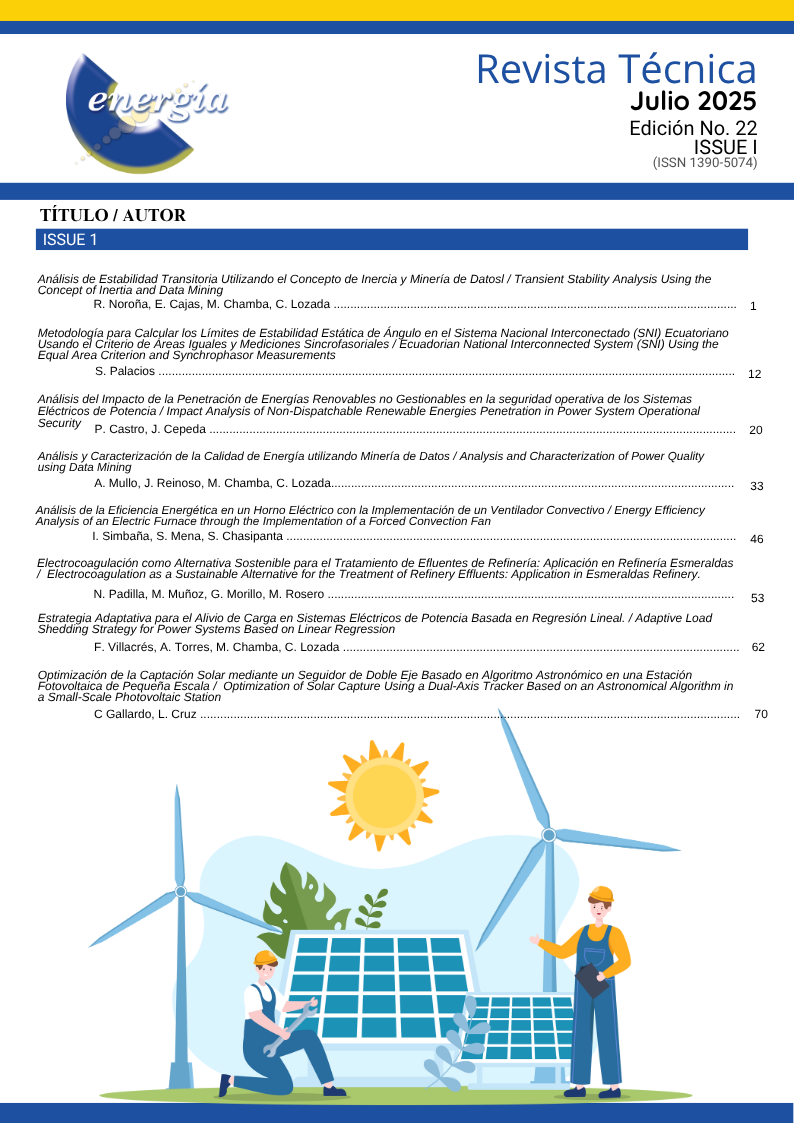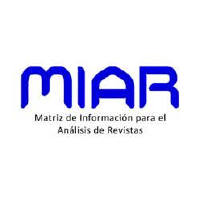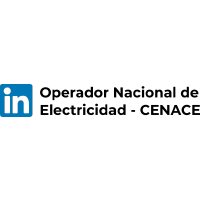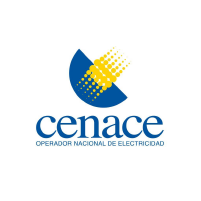Análisis y Caracterización de la Calidad de Energía utilizando Minería de Datos
Analysis and Characterization of Power Quality using Data Mining
Cómo citar
Descargar cita
Mostrar biografía de los autores
Artículos similares
- Edison Novoa, Gabriel Salazar Yépez, Eliana Buitrón, Gabriel Salazar Pérez, Propuesta de una Metodología para la Focalización del Subsidio Eléctrico “Tarifa De La Dignidad” en Usuarios Residenciales de las Empresas Eléctricas del Ecuador , Revista Técnica "energía": Vol. 20 Núm. 1 (2023): Revista Técnica "energía", Edición No. 20, ISSUE I
- José Castro, Paúl Soto, Ruth Reategui, Tuesman Castillo, Partición de una Red Eléctrica de Distribución Aplicando Algoritmos de Agrupamiento K-means y DBSCAN , Revista Técnica "energía": Vol. 20 Núm. 1 (2023): Revista Técnica "energía", Edición No. 20, ISSUE I
- Jorge Lara, Mauricio Samper, Graciela Colomé, Predicción a corto plazo de sistemas de medición inteligentes mediante arquitecturas de aprendizaje profundo multivariable y multipaso , Revista Técnica "energía": Vol. 21 Núm. 1 (2024): Revista Técnica "energía", Edición No. 21, ISSUE I
- Rolando Noroña, Edgar Cajas, Carlos Lozada, Marlon Chamba, Análisis de Estabilidad Transitoria Utilizando el Concepto de Inercia y Minería de Datos , Revista Técnica "energía": Vol. 22 Núm. 1 (2025): Revista Técnica "energía", Edición No. 22, ISSUE I
- William Yugcha, Diego Pichoasamin, Paúl Astudillo, Comparación y Optimización del Uso de Filtro Pasivo y Activo de Potencia para Mitigar Armónicos en Redes de Distribución con Cargas no Lineal , Revista Técnica "energía": Vol. 21 Núm. 1 (2024): Revista Técnica "energía", Edición No. 21, ISSUE I
- Carlos Lozada, David Panchi, Wilson Sánchez, Andrés Jacho, Regresión Lineal para la Identificación del Punto de Máxima Potencia en Microrredes Híbridas Implementado en HYPERSIM , Revista Técnica "energía": Vol. 20 Núm. 2 (2024): Revista Técnica "energía", Edición No. 20, ISSUE II
- Armando Freire, Fernando Arias, Héctor Mullo, Jhonny Casa, Implementación de Control Remoto para la Apertura y Cierre de Compensación Reactiva al Alimentador de 13,8 kV de la Subestación Eléctrica de la Empresa Novacero S.A. mediante una Tarjeta ADVC-IOEX , Revista Técnica "energía": Vol. 21 Núm. 1 (2024): Revista Técnica "energía", Edición No. 21, ISSUE I
- Wilson Pavón, Sandra Gualotuña, Estrategia de control robusto descentralizado para una micro-red aislada con generación distribuida acoplada para mejorar la estabilidad de voltaje. , Revista Técnica "energía": Vol. 20 Núm. 2 (2024): Revista Técnica "energía", Edición No. 20, ISSUE II
- Carlos Molina , Vladimir Bonilla, Aplicación de la Metodología CRISP-DM en el Análisis de Gases Disueltos en Aceite Dieléctrico de Transformadores Eléctricos del Sector Eléctrico Ecuatoriano , Revista Técnica "energía": Vol. 21 Núm. 1 (2024): Revista Técnica "energía", Edición No. 21, ISSUE I
- Julio Lascano, Luis Chiza, Roberth Saraguro, Carlos Quinatoa, Jessy Tapia, Estimación de la Demanda de una Estación de Carga para Vehículos Eléctricos Mediante la Aplicación de Métodos Probabilísticos , Revista Técnica "energía": Vol. 20 Núm. 1 (2023): Revista Técnica "energía", Edición No. 20, ISSUE I
También puede Iniciar una búsqueda de similitud avanzada para este artículo.
Artículos más leídos del mismo autor/a
- Carlos Lozada, David Panchi, Wilson Sánchez, Andrés Jacho, Regresión Lineal para la Identificación del Punto de Máxima Potencia en Microrredes Híbridas Implementado en HYPERSIM , Revista Técnica "energía": Vol. 20 Núm. 2 (2024): Revista Técnica "energía", Edición No. 20, ISSUE II
- Andrés Jacho, Diego Echeverría, Santiago Chamba, Carlos Lozada, Wilson Sánchez, Aplicación del Control Formador de Red en Microrredes con Sistemas de Almacenamiento de Energía para la Regulación Primaria de Frecuencia, Caso de Estudio: Islas Galápagos , Revista Técnica "energía": Vol. 21 Núm. 1 (2024): Revista Técnica "energía", Edición No. 21, ISSUE I
- Augusto Riofrío, Marlon Chamba, Jaime Cepeda, Yirabel Lecaro, Franklin Chimarro, Miguel Mora, Evaluación Probabilística y Gestión del Riesgo de la Cargabilidad de la Red por la Puesta en Servicio del Metro de Quito considerando el Movimiento Estocástico de los Trenes Eléctricos , Revista Técnica "energía": Vol. 15 Núm. 2 (2019): Revista Técnica "energía", Edición No. 15
- Wilson Sánchez, Diego Echeverría, Santiago Chamba, Andrés Jacho, Carlos Lozada, Despacho Económico de Energía de la Microrred en las Islas Galápagos Utilizando la Plataforma SimSEE , Revista Técnica "energía": Vol. 21 Núm. 1 (2024): Revista Técnica "energía", Edición No. 21, ISSUE I
- Carlos Lozada, David Panchi, Implementación de Hardware In The Loop para el Análisis de Escenarios de Control de Frecuencia en una Microrred Utilizando WAMS , Revista Técnica "energía": Vol. 19 Núm. 2 (2023): Revista Técnica "energía", Edición No. 19, ISSUE II
- Marlon Chamba, Walter Vargas, Jaime Cepeda, Evaluación probabilística de la estabilidad transitoria considerando la incertidumbre de la demanda y gestión del riesgo , Revista Técnica "energía": Vol. 15 Núm. 1 (2018): Revista Técnica "energía", Edición No. 15
- Rolando Noroña, Edgar Cajas, Carlos Lozada, Marlon Chamba, Análisis de Estabilidad Transitoria Utilizando el Concepto de Inercia y Minería de Datos , Revista Técnica "energía": Vol. 22 Núm. 1 (2025): Revista Técnica "energía", Edición No. 22, ISSUE I
- Flavio Villacrés, Alexis Torres, Marlo Chamba, Carlos Lozada, Estrategia Adaptativa para el Alivio de Carga en Sistemas Eléctricos de Potencia Basada en Regresión Lineal , Revista Técnica "energía": Vol. 22 Núm. 1 (2025): Revista Técnica "energía", Edición No. 22, ISSUE I
El presente trabajo aborda la problemática de la calidad de energía en redes de distribución eléctrica, enfocándose en la identificación y evaluación de distorsiones armónicas, las cuales pueden afectar el funcionamiento de equipos y el cumplimiento normativo. Para ello, se implementó una metodología que combina el análisis univariante a fin de verificar el cumplimiento con las normas IEEE 519-2022 y ARCONEL 009/2024, junto con técnicas de minería de datos como el Análisis de Componentes Principales (PCA) y el algoritmo de clústeres K-Means, que permiten clasificar los armónicos según su comportamiento en el sistema eléctrico. La metodología fue validada a través del análisis del histórico de armónicos de una industria cementera, cuya red de distribución opera a 22 kV. Los resultados permitieron identificar periodos críticos en los que se superan los límites normativos, principalmente por el funcionamiento de variadores de frecuencia, inversores y rectificadores asociados a procesos industriales como extracción de materia prima, molienda, precalentamiento, calcinación, ensacado y despacho. El modelo desarrollado demostró ser eficaz para procesar grandes volúmenes de datos, detectar las principales fuentes de distorsión armónica y segmentar el comportamiento por horario y día, lo que facilita la implementación de estrategias de mitigación y su adaptación a diferentes entornos industriales.
Visitas del artículo 529 | Visitas PDF 111
Descargas
- M. M. Irfan, M. Alharbi, y C. H. H. Basha, «Artificial neural network controlled DSTATCOM for mitigating power quality concerns in solar PV and wind system», Sci. Rep., vol. 15, n.o 1, 2025, doi: 10.1038/s41598-025-88540-0.
- M. Pérez Martínez et al., «Desarrollo de aplicaciones en el software Scilab para el análisis de armónicos en sistemas industriales», Ing. Energética, vol. 43, n.o 1, pp. 24-34, abr. 2022.
- L. Amaya-Vásquez, E. Inga-Ortega, L. Amaya-Vásquez, y E. Inga-Ortega, «Localización de Distorsiones Armónicas en Sistemas Eléctricos usando Sensado Comprimido», Ing. Compet., vol. 24, n.o 1, jun. 2022, doi: 10.25100/iyc.24i1.11037.
- «IEEE Std 519-2022 (Revision of IEEE Std 519-2014)», IEEE Std 519-2022 Revis. IEEE Std 519-2014, pp. 1-31, ago. 2022, doi: 10.1109/IEEESTD.2022.9848440.
- ARCONEL, Resolución Nro. ARCONEL-016/2024. 2024. [En línea]. Disponible en: https://controlelectrico.gob.ec/wp-content/uploads/downloads/2024/10/Regulacion-ARCONEL-006-24-1-3.pdf
- J. C. Gonzales Arispe y A. Y. Marca Yucra, «Análisis de armónicos en sistemas eléctricos de potencia y normas regulatorias: impacto del horno de arco eléctrico de acerías», Ingeniare Rev. Chil. Ing., vol. 32, pp. 0-0, 2024, doi: 10.4067/s0718-33052024000100201.
- S. S. Cembranel, F. Lezama, J. Soares, S. Ramos, A. Gomes, y Z. Vale, «A Short Review on Data Mining Techniques for Electricity Customers Characterization», en 2019 IEEE PES GTD Grand International Conference and Exposition Asia (GTD Asia), mar. 2019, pp. 194-199. doi: 10.1109/GTDAsia.2019.8715891.
- B. L. Tarcsay, Á. Bárkányi, T. Chován, y S. Németh, «A Dynamic Principal Component Analysis and Fréchet-Distance-Based Algorithm for Fault Detection and Isolation in Industrial Processes», Processes, vol. 10, n.o 11, Art. n.o 11, nov. 2022, doi: 10.3390/pr10112409.
- L. J. Lepolesa, S. Achari, y L. Cheng, «Electricity Theft Detection in Smart Grids Based on Deep Neural Network», IEEE Access, vol. 10, pp. 39638-39655, 2022, doi: 10.1109/ACCESS.2022.3166146.
- J. Castro, P. Soto, R. Reategui, y T. Castillo, «Partición de una Red Eléctrica de Distribución Aplicando Algoritmos de Agrupamiento K-means y DBSCAN», Rev. Téc. Energ., vol. 20, n.o 1, Art. n.o 1, jul. 2023, doi: 10.37116/revistaenergia.v20.n1.2023.572.
- L. Marrero et al., «Uso de algoritmo K-means para clasificar perfiles de clientes con datos de medidores inteligentes de consumo eléctrico: Un caso de estudio», Ingeniare Rev. Chil. Ing., vol. 29, n.o 4, pp. 778-787, dic. 2021, doi: 10.4067/S0718-33052021000400778.
- C. Yajure, «Aplicación de la metodología de Ciencia de Datos para analizar datos de facturación de energía eléctrica. Caso de estudio: Uruguay 2000-2022», ResearchGate, doi: 10.15381/risi.v15i1.23544.
- C. Yajure, «Uso de algoritmos de Machine Learning para analizar los datos de energía eléctrica facturada en la Ciudad de Buenos Aires durante el período 2010–2021», ResearchGate, oct. 2022, doi: 10.22206/cyap.2022.v5i2.pp7-37.
- O. Yu. Maryasin y A. I. Lukashov, «A Python Application for Hourly Electricity Prices Forecasting Using Neural Networks», en 2020 International Russian Automation Conference (RusAutoCon), sep. 2020, pp. 138-143. doi: 10.1109/RusAutoCon49822.2020.9208035.
- «Advanced Distribution Measurement Technologies and Data Applications for Smart Grids: A Review», ResearchGate, dic. 2024, doi: 10.3390/en13143730.
- E. I. F. Cruz, «Análisis de Componentes Principales de la Tarifa de Electricidad en México – Caso de Estudio», Cienc. Lat. Rev. Científica Multidiscip., vol. 8, n.o 4, Art. n.o 4, sep. 2024, doi: 10.37811/cl_rcm.v8i4.13173.
- D. Garcia-Alvarez y M. J. Fuente, «Estudio comparativo de técnicas de detección de fallos basadas en el Análisis de Componentes Principales (PCA)», Rev. Iberoam. Automática E Informática Ind. RIAI, vol. 8, n.o 3, pp. 182-195, jul. 2011, doi: 10.1016/j.riai.2011.06.006.
- J. Zhuang, M. Dong, J. Lin, M. Liu, y K. Lin, «Electricity charge anomaly detection based on PCA-IK-means», en 2023 IEEE 3rd International Conference on Power, Electronics and Computer Applications (ICPECA), ene. 2023, pp. 1714-1718. doi: 10.1109/ICPECA56706.2023.10076038.
- E. Pérez-Montalvo et al., «Model of monthly electricity consumption of healthcare buildings based on climatological variables using PCA and linear regression», Energy Rep., vol. 8, pp. 250-258, nov. 2022, doi: 10.1016/j.egyr.2022.06.117.
- J. Wang y X. Li, «Abnormal Electricity Detection of Users Based on Improved Canopy-Kmeans and Isolation Forest Algorithms», IEEE Access, vol. 12, pp. 99110-99121, 2024, doi: 10.1109/ACCESS.2024.3429304.
- G. Ruiz Aranibar, «Análisis de conglomerados», Rev. Varianza, vol. 16, oct. 2019, Accedido: 10 de marzo de 2025. [En línea]. Disponible en: http://revistasbolivianas.umsa.bo/scielo.php?script=sci_abstract&pid=&lng=en&nrm=iso&tlng=
- M. Dimishkieh y A. H. Ramzi, «An Enhanced k-Means Clustering Algorithm for Pattern Discovery in Healthcare Data», Sage J., jul. 2019, doi: https://doi.org/10.1155/2015/6157.
- M. F. Abdullah, N. H. Hamid, Z. Baharudin, M. A. M. Ayob, y M. A. F. M. Hamim, «Characteristic of third harmonic from synchronous generator passing through transformer and rectifier», en 2012 IEEE International Conference on Power and Energy (PECon), dic. 2012, pp. 689-694. doi: 10.1109/PECon.2012.6450303.
- A. R. Bonilla y H. T. Le, «Analysis and Mitigation of Harmonics for a Wastewater Treatment Plant Electrical System», WSEAS Trans. Circuits Syst., vol. 23, pp. 1-13, 2024, doi: 10.37394/23201.2024.23.1.



























